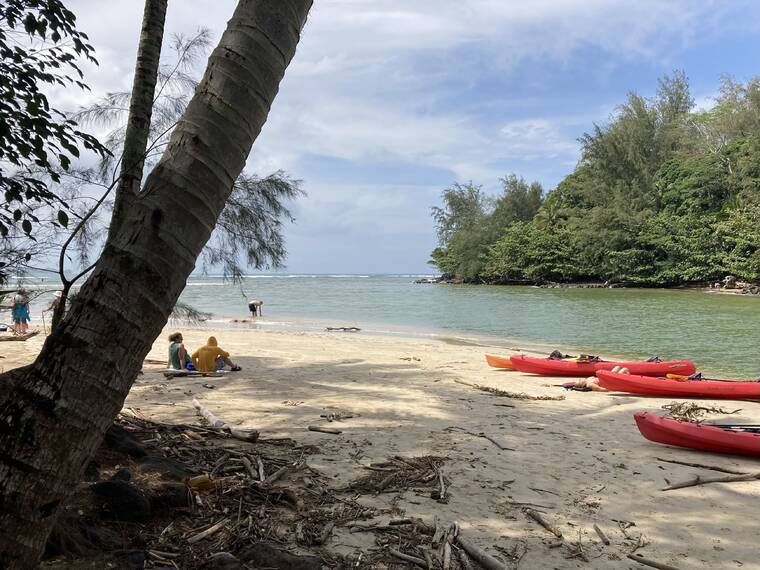LIHU‘E — Environmental organization Surfrider Kaua‘i’s Blue Water Task Force found large amounts of bacteria in several of Kaua‘i’s waters this month, suggesting that ongoing concerns over fecal contamination of the Garden Island’s streams and beaches are far from over.
Every month, Surfrider Kaua‘i analyzes samples of streams, rivers and surf spots across the island to check for the enterococcus bacterium, a federally recognized indicator of fecal presence in water.
In its March report, the task force found that only six of its 19 tested sites — Kalihiwai, Kealia, Middles (Hanalei), Waikoko (Hanalei), Waiohai (Po‘ipu) and Salt Pond Beach Park — indicated low bacterial presence, measuring below 35 enterococci per 100 milliliters of water. Middles and Kalihiwai previously measured in at medium and high counts of the bacteria, respectively.
Three of the measured sites — Anahola Bay, Kalapaki Bay and Rock Quarry (Kahili Beach, Kilauea) — indicated medium bacterial presence, measuring between 36 and 130 enterococci per 100 milliliters of water. Anahola Bay showed an increase in bacterial content from February, while Kalapaki Bay decreased from high counts of enterococci.
Unfortunately for Kaua‘i beachgoers, the majority of tested sites — Wainiha Stream mouth, Wailua River mouth, The Bowl at Hanalei, Hanalei River at Weke Road, Hanama‘ulu Beach, Moloa‘a Stream mouth, Waikomo Stream at Koloa Landing, Hanama‘ulu Stream mouth, Nawiliwili Stream and Pakala — all measured over 130 enterococci per 100 milliliters of water, indicating high amounts of contamination in excess of state water quality standards.
Of all of March’s contaminated waters, Pakala is the most notable. While the surf spot measured high counts of bacteria in February, at 185 organisms per 100 milliliters of water, its bacteria content skyrocketed to 10,462 organisms in March — over 80 times higher than state standards.
Most surprisingly, the surf hadn’t measured above a low bacteria count in all of 2022.
Carl Berg, Surfrider Hawai‘i Kaua‘i Chapter senior scientist, says this sudden and sizable uptick in contamination can almost certainly be attributed to the record amounts of rainfall received by the island this year.
“Our winter rainfall events show that when you have a lot of continuous rain, you’re going to really wash off the surface,” Berg said. “And you’re going to get a major groundwater infiltration by the rainwater getting into all of the cesspools.”
Kaua‘i’s waters are primarily polluted through surface runoff and underground pollutant leeching. Above ground, rainwater washes animal feces and other open-air contaminants into the island’s rivers. Beneath the surface, rainwater percolates through the ground, pulling human and chemical waste — largely from Kaua‘i’s 14,000 cesspools — into the waters.
While Surfrider’s monthly measurements are still useful for finding more immediate water conditions, Berg highly recommends checking the organization’s geomean data to find longer term contamination trends.
“If it’s chronically polluted, do you want to take a chance going there rather than go someplace else?” he asked. “We’re giving you all the data. You can make an intelligent decision whether you want to take a chance or not with your public health, or with your kid’s health.”
Data from the Blue Water Task Force water quality report is available at bwtf.surfrider.org/report/23.
•••
Jackson Healy, reporter, can be reached at 808-647-4966 or jhealy@thegardenisland.com.





Google: “Feds Debunk Surfrider’s Fake Bacteria Counts”
How come these articles never mention the influence of pig urine and feces being a major contributor to the bacteria count?
It’s as if there’s an agenda to only point to problems stemming from human septic systems.
Moloa’a stream has very few houses along its length, but a huge watershed full of feral pigs.
HELLO, any editors awake at the Garden Island??
WHO monitors the portable toilet company on the stream in Hanamaulu????? I am sure they contribute huge amount of feces to the Hanamaulu stream,,,,